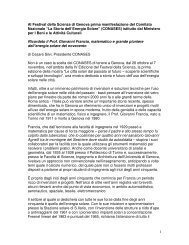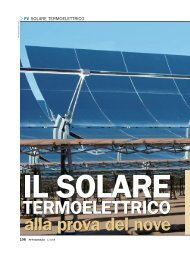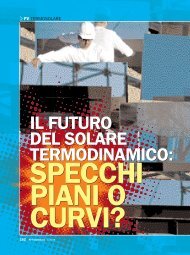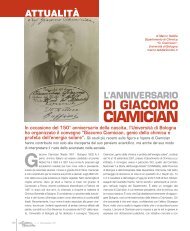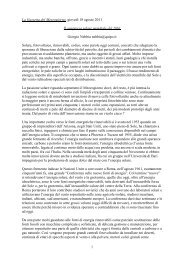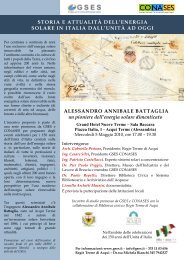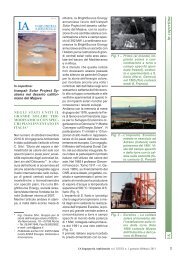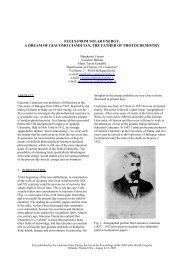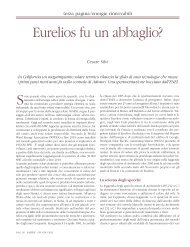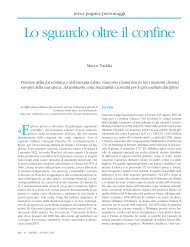The Pioneering Work On Linear Fresnel Reflector ... - GSES
The Pioneering Work On Linear Fresnel Reflector ... - GSES
The Pioneering Work On Linear Fresnel Reflector ... - GSES
Create successful ePaper yourself
Turn your PDF publications into a flip-book with our unique Google optimized e-Paper software.
THE PIONEERING WORK ON LINEAR FRESNEL REFLECTOR<br />
CONCENTRATORS (LFCs) IN ITALY<br />
Cesare Silvi<br />
Italian Group for the History of Solar Energy (<strong>GSES</strong>), Via Nemorense, 18 – 00199 Rome, Italy,<br />
Phone: +39 06 8411649, Fax: +39 06 8552652, E-Mail: csilvi@gses.it<br />
Abstract<br />
This paper presents some of the results of recent historical research on pioneering work on <strong>Linear</strong> <strong>Fresnel</strong><br />
<strong>Reflector</strong> Concentrators done in Italy during the 19 th and the 20 th centuries, with special focus on the work by<br />
Giovanni Francia (1911-1980), a self-educated mathematician, once known as the father of solar<br />
thermoelectric power plants.<br />
<strong>The</strong> research studies have been carried out on archive materials, such as notes, letters, articles, drawings and<br />
patents, identified and collected by <strong>GSES</strong> (Italian group for the history of solar energy) and CONASES<br />
(Italian Committee ‘<strong>The</strong> History of Solar Energy’) in the framework of the Italian Program on the History of<br />
Solar Energy.<br />
Francia’s personal archive, which his family donated in 2005 to the Museum of Industry and <strong>Work</strong> (Musil) in<br />
the northern Italian city of Brescia (www.musil.bs.it), provided much research material. This documentation<br />
unveiled Francia’s pioneering but little-known work on LFCs in the early 1960s, which anticipated many of<br />
what are today the key aspects of this technology.<br />
Keywords: solar history, solar concentration, <strong>Fresnel</strong> linear reflector, solar power plant, Giovanni Francia,<br />
Italy.<br />
1. Introduction<br />
Studies and experiments on burning mirrors and other solar technologies developed in Italy during the<br />
Renaissance period have received attention and cited often in literature [1].<br />
<strong>On</strong> the contrary, Italian first attemps to develop solar concentration technologies to power industrial<br />
activities, produce steam and electricity are less well known. A challenge that Italy, lacking in coal and other<br />
fossil fuels, started to take at the beginning of the 19 th century and found success in the work of Giovanni<br />
Francia (1911-1980), among the greatest solar pioneers of the 20 th century.<br />
With the aim of rediscovering that work, historical studies were started by the author in 1999 [2]. <strong>The</strong>y are<br />
part of the Italian program on the history of solar energy, promoted by the Italian group for the history of<br />
solar energy (<strong>GSES</strong>) and by the Italian Committee '<strong>The</strong> History of Solar Energy' (CONASES) [3]. <strong>On</strong>e<br />
objective of <strong>GSES</strong> and CONASES is to make the results of this research accessible on the internet through a<br />
digital archive, which is currently being created with its on line debut slated for 2011 [4].<br />
In the following paragraphs some of the results of this work, which is still in progress, are presented, with a<br />
focus on emerging concepts in <strong>Linear</strong> <strong>Fresnel</strong> <strong>Reflector</strong> Concentrators during the 19 th century and on the<br />
unique contribution made by Francia, who was the first at world level to build and test an LFC in a real<br />
system prototype in the early 1960s.<br />
2. Solar concentration in Italy for solar steam production prior to Francia<br />
2.1 Mouchot, Pifre and Battaglia<br />
In 1860, 100 years before Francia came on the stage, Augustine Mouchot, a professor of mathematics at the<br />
Lyceé de Tours in France, began to explore the possibility of transforming the sun's heat into mechanical<br />
energy. In his well known book "La Chaleur Solaire et ses Applications Industrielles" of 1869 [5], he<br />
observed:
<strong>On</strong>e must not believe, despite the silence of modern writings, that the idea of using heat for mechanical<br />
operations is recent. <strong>On</strong> the contrary, one must recognize that this idea is very ancient and in its slow<br />
development across the centuries it has given birth to various curious devices.<br />
In 1878 Mouchot exhibited at the Universal Exposition in Paris what is commonly known to be the first and<br />
largest machine in the world to produce solar steam. Mouchot’s sun machine was subsequently improved by<br />
his assistant Abel Pifre, by adopting a spherical parabolic solar collector to power a printing press [1].<br />
Fig. 1. Left, Augustine Mouchot’s sun machine, the largest of its time, on display at the Universal<br />
Exposition in Paris in 1878. Right, Abel Pifre’s solar-powered printing press, exhibited at the Gardens<br />
of the Tuileries in Paris 1880 [1] [5].<br />
<strong>The</strong>se developments in France were noted in several other countries, especially in those lacking in coal and<br />
other fossil fuels. In Italy, Alessandro Battaglia (1842 – n.a.), an Italian engineer from Acqui Terme, thought<br />
that the Mouchot-Pifre designs, despite their merits, also had several inherent limitations that he illustrated in<br />
1884 at the Istituto di Incoraggiamento di Napoli (Encouragement Institute of Naples) [6].<br />
In his paper “Sul modo e sulla convenienza di utilizzare il calor solare per le macchine a vapore” (<strong>On</strong> the<br />
methods and convenience of using solar heat for steam engines) Battaglia illustrated the limitations of the<br />
Mouchot-Pifre designs:<br />
- It is not possible to build boilers of sufficient capacity to power industrial engines due to the fact<br />
that the boiler is mounted on the tracking collector, which limits its size;<br />
- <strong>The</strong> boiler loses its heat easily because it is exposed to open air and cannot be insulated and<br />
protected;<br />
- <strong>The</strong> tracking collector, as a single surface, is also limited in its total area.<br />
To overcome these limitations, Battaglia proposed separating the boiler from the collecting reflector area. He<br />
proposed a horizontal cylindrical boiler 30 meters in length and 1 meter in diameter, enclosed inside an<br />
insulating brick oven with a window of the same length as the boiler and 1 meter in height, facing a separate<br />
collecting reflector area made up of 1250 small flat mirrors, one square meter each, distributed in 42 rows of<br />
30 mirrors each. <strong>The</strong> system, which he described in economic and technical details, was estimated to have an<br />
output of 50 HP (37.3 kW), with an approximate cost of 100,000 lire in 1884 or 420,233 in 2008 Euros.<br />
In 1884, Battaglia applied for a patent for his invention as a “Collettore multiplo solare” (Multiple Solar<br />
Collector), though with a boiler of just 10 meters and only 250 of the 1250 flat mirrors indicated in his paper.<br />
Battaglia’s patent is illustrated in the following drawings in figure 2, courtesy of the Central State Archive,<br />
Rome, Italy.<br />
<strong>The</strong> purpose of Battaglia’s invention, as explained in his patent, is “to collect the solar rays that strike a<br />
specific portion of the earth’s surface at any latitude, and to reflect them, concentrated in a specially shaped<br />
beam, onto a specific surface of limited size, in order to obtain a high temperature and a quantity of calories<br />
capable of causing a specific effect, at a cost relatively small for the size of the reflecting surface. <strong>The</strong><br />
surfaces that receive and reflect the solar rays are metallic, silver-coated and burnished. <strong>The</strong> reflection must<br />
be continuous; that is, it must be aimed at the same point every day of the year, from sunrise to sunset [7].”
Fig. 2. Left, Cross section of the collecting reflector area and the longitudinal grounded boiler, one<br />
meter in height, installed inside a brick oven, insulating and protecting the boiler and with an opened<br />
window facing the reflector area. Right, Plan of the collecting reflector area and of the longitudinal or<br />
linear boiler, roughly ten meters in length.<br />
<strong>The</strong> Multiple Solar Collector was Battaglia’s answer to the challenges of building large collectors, on which<br />
many scholars and scientists speculated during the 16 th and the 17 th centuries as illustrated in figure 3.<br />
Fig. 3. From a Golden Thread by Butti and Perlin: a large burning mirror of the late 1700’s built in<br />
sections [1].<br />
Battaglia’s approach, which won him special recognition from the Istituto di Incoraggiamento di Napoli,<br />
overcame, in theory, some of the limitations in the Mouchot-Pifre designs, though there still remained<br />
obstacles, that had already been encountered in the past, as shown in the image in figure 3. Judging from the<br />
drawings in Battaglia’s patent, the grounded boiler would require the mirrors to face downward and therefore<br />
are limited in the amount of sunrays they can capture and reflect toward the receiver.<br />
In any event, Battaglia introduced new concepts, such as a longitudinal or linear receiver and a multiple<br />
reflector area made of many small and flat reflectors, each one tracking the sun independently. Both the<br />
reflector area and the boiler could therefore grow in size to collect large quantities of solar energy in order to<br />
meet modern industrial demands.<br />
Historical research on Battaglia’s theories, as well as other work based on his patent registered in 1886,<br />
continue today. For example, research is being carried out to determine if Battaglia ever succeeded in<br />
building and testing a demonstration plant, as he was recommended to do by the Istituto di Incoraggiamento<br />
di Napoli during his presentation in 1884.<br />
2.2 Other little known Italian attempts in the 19 th century to produce solar steam<br />
Prior to Battaglia’s work, other Italians had considered the possibility of building large solar concentrators to<br />
produce solar steam during the 19 th century. Among them it is worth recalling Pasquale Gabelli (1801 –1882)<br />
and Bartolomeo Foratti. Gabelli, a professor of mathematics and natural science, born near Pordenone in<br />
northern Italy, presented a handwritten document “Sopra un nuovo meccanismo per dirigere i raggi solari<br />
condensati ad usi speciali” (<strong>On</strong> a new mechanism to direct condensed solar rays for special purposes) at the
Ateneo Veneto, a scientific and cultural institute in Venice, on August 25, 1838. In references made to this<br />
40-page document and its annexed drawings, Gabelli is said to describe a solar concentrating system made up<br />
of many small flat mirrors individually positioned and mounted on a large two axis heliostat, which he<br />
experimented in 1861 [8].<br />
Bartolomeo Foratti further developed Gabelli’s solar concentration system and described it in a document<br />
entitled “Su d'un suo apparecchio per la concentrazione dei raggi solari e loro applicazione al riscaldamento”<br />
(Apparatus for concentration of solar rays and their application to heating), which he also presented at the<br />
Ateneo Veneto on July 8, 1869. Foratti envisioned the construction of what he referred to as a Pirocatoforo,<br />
similar to Gabelli’s design, to be used for heating boilers in steam powered stationary machines, to produce<br />
high temperatures for agriculture, heating greenhouses and desalination [9].<br />
<strong>The</strong>se 19 th century Italian concepts and attempts by Gabelli, Foratti and Battaglia to produce solar steam<br />
seem to have been completely forgotten in the following decades. Research has thus far failed to turn up any<br />
traces in the Italian scientific literature of the late 1800s and early 1900s.<br />
<strong>On</strong>e explanation for this could be that at the time Italy was searching for alternatives to coal and oil, which it<br />
found in the use of hydro energy from the Alps. This Italian white coal was used to produce electricity and<br />
power the Italian industrial revolution, from textile to other manufacturing activities. In 1898, the first<br />
hydroelectric plant was built in Paderno d’Adda and at 10 MW, it was the largest in Europe at the time.<br />
Additional plants were built in the following years. Prior to WWII, hydro energy was providing 92% of all<br />
total electricity production in Italy [2].<br />
In the first half of the 20 th century, solar concentration technology throughout the world continued to be<br />
dominated primarily by parabolic troughs and dishes as shown from photos in figure 6, with a receiver<br />
mounted on curved mirrors. It wasn’t until the early 1960’s that a revolutionary new approach to solar<br />
concentration was made in Italy by Giovanni Francia, who, as Battaglia before him, separated the boiler from<br />
the reflecting area, but took a new approach by suspending a linear or point boiler above multiple reflectors<br />
with one or two axis tracking.<br />
Fig. 4. Left, Parabolic trough concentrator, Meadi, Egypt, 1912, for steam production used in<br />
powering a solar pump [1]. Right, a solar oven at the Observatoire de Bouzaréah in Algeria, which in<br />
the early 1950’s was among the most powerful in the world, with a collecting area of 50 m 2 (Marcel<br />
Perrot Archive).<br />
3. Giovanni Francia and the sun’s heat<br />
3.1 Honeycomb structure and first solar boiler<br />
Born in Turin in 1911, Francia was a self-educated mathematician who made important contributions to<br />
various fields, such as motor vehicles, aircraft, space, textiles, and electro mechanics. Starting in the late<br />
1950’s and continuing until his death in 1980, he developed a special interest in solar energy and devoted<br />
most of his time to developing solar technologies, rediscovering concepts and reinventing solutions that had<br />
already been considered in the past by other Italians. To learn more about Francia’s pioneering work in solar<br />
energy, see reference [10].<br />
Francia presented his pioneering work on solar concentration in the 1968 issue of the journal Solar Energy<br />
[11].
He began working with the idea of collecting solar heat in order to obtain the high temperatures used in<br />
modern industries, such as to run large turbines at power plants. His first step toward raising the solar energy<br />
collection temperature was to invent the honeycomb structure, an array consisting of a large number of long,<br />
thin, parallel tubes made of glass, quartz or plastic. Being transparent to solar radiation but opaque to the heat<br />
rays emitted by the hot surface, the array served to reduce the collector's losses from re-irradiation and<br />
convection.<br />
Figure 5 shows the design for the first honeycomb system that Francia built in early 1960 for the sole purpose<br />
of testing the theory he was elaborating. In this case, the honeycomb was made up of hexagonal tubes 8 mm<br />
in diameter and 160 mm long. <strong>The</strong> device produced temperatures of 230-240°C, far lower than the 500°C<br />
expected theoretically. Between 1960 and 1961, Francia built the first experimental solar station at Cesana<br />
Torinese, coupling a boiler with a concentrator protected by a honeycomb structure made up of 2000 thin<br />
glass tubes. Francia’s experimental station succeeded in reaching the temperature of 600°C.<br />
Fig. 5. Left: first honeycomb absorber that Francia built in 1960; Right: Photos of the first boiler<br />
coupled with a concentrator and protected by a honeycomb structure tested in Cesana Torinese in<br />
1960/1961 (Francia Archive, Musil Brescia).<br />
He then translated his honeycomb structure, theory and experimental results into his first solar patent [12],<br />
which he presented at the United Nations Conference on New Energy Sources (solar, wind, geothermal), held<br />
in Rome at the headquarters of FAO, the U.N. Food and Agriculture Organization [13], where he gained<br />
international recognition. At this Congress he met Marcel Perrot (1908-2006) of the Solar Research Group at<br />
the University of Marseille (France), with whom he started a fruitful cooperation in solar energy.<br />
3.2 Francia and <strong>Linear</strong> <strong>Fresnel</strong> Concentrators (LFCs)<br />
Francia was the first person in the world to apply the <strong>Fresnel</strong> reflector concentrator concept in actual linear<br />
and point focus systems (LFCs and PFCs). He filed his first LFC patent in 1962, in Italy [14]. <strong>The</strong> next year,<br />
he designed and built the first LFC prototype, in Genoa, and in 1964 he assembled and tested it at the<br />
Lacédémone-Marseilles solar station, in cooperation with Marcel Perrot, and with support from France’s<br />
National Research Council (CNRS), NATO and COMPLES (Coopération Méditerranée pour l’Energie<br />
Solaire).<br />
Fig. 6. Left: drawing of the patented LFC; Right: Photos of Francia’s first LFC prototype (Francia<br />
Archive, Musil Brescia).<br />
As described in a note, this initial LFC unit was built by GRESUMG (Gruppo Ricerca Energia Solare<br />
Università Marsiglia Genova - Solar Energy Research Group, Marseilles and Genoa Universities) and stood
on an area of approximately 8.2 x 7.9 m 2 . It had 7 aluminum mirrors, 8 meters long and 1 meter wide,<br />
parallel to each other on an east-west line. Each mirror rotated around its lengthwise axis, concentrating solar<br />
radiation on a linear boiler positioned parallel to the mirrors at a height of about 6 meters. <strong>The</strong> rotary motion<br />
was the same for all the mirrors, and was obtained by means of an electronic command guided by the sun<br />
itself. <strong>The</strong> boiler was slightly less than 8 meters long and 25 centimeters wide. It was protected on the front<br />
(the side facing the mirrors) by the honeycomb structure and on the back by appropriate insulation and a lostheat-recovery<br />
device [15].<br />
Two flat vertical mirrors limited energy loss on the west side in the morning and on the east side in the<br />
afternoon; otherwise, reflected energy would reach the boiler only during the midday hours, due to the short<br />
length of the mirrors. In the design for the large solar plant described in Francia’s patent no. 18634, of which<br />
the Marseilles plant was the first unit, the aluminum-mirror strips were much longer than the boiler is high,<br />
which eliminated the need of protective mirrors on the sides. Likewise, the Marseilles unit was designed to<br />
be scalable; the length of the strips of mirrors could be tripled or quadrupled and their number increased. <strong>The</strong><br />
plant was built with off-the-shelf materials in order to simplify the construction and reduce costs, with the<br />
idea to perfect them based on the experimental results obtained with the prototype. <strong>The</strong> plant generated 38<br />
kg/h of steam at 100 atm and 450°C.<br />
<strong>The</strong> plant was expected to supply around 1200 thermal kWh annually per square meter of mirrors in<br />
Marseille, making a total of 67,200 kWh per year. If the plant had been built in Sicily, Francia calculated<br />
that production would have reached 1600 kWh per year per square meter, for a total of 89,600 kWh annually.<br />
According to Francia’s evaluation at the time, with a large-scale plant, the power output could be much<br />
cheaper per kWh than that generated from oil. For Francia, the use of flat mirrors was fundamental in order<br />
to build large-scale plants, as he stated in his correspondence with M. Touchais, a collaborator of Marcel<br />
Perrot [16] [17].<br />
In the late sixties, Francia, in cooperation with his collaborators, elaborated the "Solar City Project –<br />
Hypothesis for an Urban Structure", by inventing a wholly new kind of urban complex for a population of<br />
around 100,000. This complex relied on the use of solar energy for natural and artificial lighting, for heating<br />
household water, for space heating and cooling, and for the production of electricity. <strong>The</strong> design centered<br />
around repeatable, independent and energetically autonomous units (18). <strong>The</strong> drawing in figure 7, dated circa<br />
1965, shows Francia’s vision of a large LFC integrated in an urban context.<br />
Fig. 7. Francia’s drawings of the envisioned large solar LFC power plant integrated in an urban<br />
context of circa 1965 (Francia Archive, Musil Brescia).<br />
After building his first LFC, Francia built the first PFC in 1965 at the Sant’Ilario solar station and began<br />
focusing mainly on solar towers, on which he devoted his efforts in the following years. He believed solar<br />
energy would become competitive for power generation only when solar boilers were improved to the point<br />
when they could produce steam at pressures above 150 atmospheres and temperatures above 500°C, a goal<br />
that seemed more likely achievable with solar towers than with linear concentration systems at the time. His<br />
work on LFC technology was thus put on the back burner.
In the late 1970s, Francia worked as a consultant for the construction of the industrial-scale solar tower<br />
facility at the Georgia Institute of Technology, in Atlanta, and for the 1 MW Eurelios power plant at Adrano,<br />
in Sicily, the first of its kind anywhere in the world to be connected to the electricity grid.<br />
Despite the fact that from 1965 onward his focus was mainly on solar towers, Francia still continued to<br />
envision large-scale LFC plants as illustrated by the following artist’s rendering, from a brochure written by<br />
Francia and his collaborators just before his death in 1980.<br />
Fig. 8 – Artist’s rendering of an LFC solar power plant designed by Giovanni Francia and<br />
collaborators in late 1970s [19].<br />
4. Conclusion<br />
<strong>The</strong> documentation from various archives, as briefly illustrated in this paper, gives us better insight into the<br />
pioneering work on LFCs in Italy. It shows that there were various attempts to develop large solar<br />
concentration systems by using a <strong>Fresnel</strong> type multiple collector area and increasing boiler efficiencies<br />
starting in the early 19 th century.<br />
In facing this challenge Giovanni Francia succeeded during the 20 th century, in just a few years, from the late<br />
1950’s to the mid 1960’s. After his first experiments on anti-radiating structures or honeycombs, he devoted<br />
his work to the development of LFCs and PFCs, not only proving to the world that solar energy could be<br />
collected at high temperatures to generate solar electricity, but also proposing the integration of large solar<br />
power plants in urban contexts, as it can be seen from his drawings and his solar city project.<br />
Acknowledgements<br />
In writing this paper I had the benefit of accounts from and contacts with many people. I would<br />
like to thank in particular P. Castellazzi, G. Nebbia, P. P. Poggio, and the heirs of G. Francia.<br />
References *<br />
[1] K. Butti, J. Perlin, A Golden Thread – 2500 years of Solar Architecture and Technology, Cheshire Books,<br />
Palo Alto, CA USA, 1980.<br />
[2] C. Silvi, Can the History of Energy Technology and Use Educate us for a Solar Energy future? <strong>The</strong><br />
Italian Case, ISREE-9 Proceedings ISES Solar World Congress 2003, Göteborg (Sweden).
[3] C. Silvi, <strong>The</strong> Italian Solar Energy History Project, Poster presentation, Proceedings ISES Solar World<br />
Congress 2007, Beijing, China.<br />
[4] C. Silvi, Italy's Archive on the History of Solar Energy, Poster presentation, Proceedings EuroSun 2008,<br />
Lisbon, Portugal.<br />
[5] A. Mouchot "La Chaleur Solaire et Ses Applications Industrielles" Paris Gauthier Villar, Imprimeur<br />
Libraire, 1869<br />
[6] Report on the submitted paper by engineer Mr. Alessandro Battaglia "<strong>On</strong> the mode and the convenience<br />
of using sun's heat," read by Professor Eugenio Semmola, session of the 17 th of April 1884, Proceedings of<br />
the Institute for Encouragement of Naples, 1884.<br />
[7] Certificate of industrial patent (13 October 1886, Vol.40, no 412) valid for three years from 30 September<br />
1886, issued to Mr. Alessandro Battaglia in Genoa for a device called Multiple Solar Collector.<br />
[8] V. Namias su P. Gabelli, Sopra un nuovo meccanismo per dirigere i raggi solari condensati ad usi<br />
speciali, Atti dell'Ateneo Veneto, Serie II, volume 6, p. 243, 1869.<br />
[9] B. Foratti, "Su d'un suo apparecchio per la concentrazione dei raggi solari e loro applicazione al<br />
riscaldamento" in Rendiconti di lettere e scienze morali e politiche, Istituto Lombardo di scienze e lettere,<br />
1871.<br />
[10] C. Silvi, <strong>The</strong> work of the Italian solar energy pioneer Giovanni Francia (1911-1980), Proceedings ISES<br />
Solar World Congress 2005, Orlando Florida USA, 2005.<br />
[11] G. Francia, Pilot Plants of Solar Steam Generation Systems, in Solar Energy V:12 (1968), pp. 51-64.<br />
[12] Italian patent no.653295, May 5, 1961; extended to France and the United States (Francia Archive,<br />
Musil Brescia).<br />
[13] G. Francia, , “Un nouveau collecteur de l’énergie rayonnante solaire. Théorie et vérifications<br />
expérimentales, E/Conf. 35/S/71, United Nations Conference on New Energy Sources. Roma, 1961 (E/Conf.<br />
35/5, pp. 554-588).<br />
[14] Italian patent no. 6788664, Nov. 23, 1962; extended to France and the United States (Francia Archive,<br />
Musil, Brescia).<br />
[15] Private note “Solar Power Plant Francia’s Type,” February 14, 1963, (Francia Archive, Musil, Brescia).<br />
[16] Letter by M. Touchais to G. Francia, December 1961, (Francia Archive, Musil, Brescia).<br />
[17] Letter by G. Francia to M. Touchais, January 1962, (Francia Archive, Musil, Brescia).<br />
[18] G. Francia, Solar City Project – Hypothesis for an Urban Structure, Proceedings COMPLES meeting,<br />
Marseilles, Bulletin 19, April 1971.<br />
[19] Ansaldo Meccanico Nucleare, CESEN, Ansaldo, Solar Energy Exploitation: High and Medium<br />
Temperature <strong>The</strong>rmodynamic Conversion, Genoa, 1980 (Castellazzi Archive).<br />
*References by the author can be downloaded at www.gses.it.




